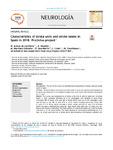Characteristics of stroke units and stroke teams in Spain in 2018: Pre2Ictus project

Use este enlace para citar
http://hdl.handle.net/2183/37253
A non ser que se indique outra cousa, a licenza do ítem descríbese como Creative Commons Attribution-NonCommercial-NoDerivs 4.0 International License (CC-BY-NC-ND 4.0)
Coleccións
- Investigación (FCS) [1295]
Metadatos
Mostrar o rexistro completo do ítemTítulo
Characteristics of stroke units and stroke teams in Spain in 2018: Pre2Ictus projectTítulo(s) alternativo(s)
Características de las unidades de ictus y equipos de ictus en España en el año 2018: Proyecto Pre2IctusAutor(es)
Data
2022-06-30Cita bibliográfica
Alonso de Leciñana M, Morales A, Martínez-Zabaleta M, Ayo-Martín Ó, Lizán L, Castellanos M; en representación de los investigadores del Proyecto Ictus, GEECV-SEN. Characteristics of stroke units and stroke teams in Spain in 2018: Pre2Ictus project. Neurologia (Engl Ed). 2023 Apr;38(3):173-180. English, Spanish.
Resumo
[Abstract]
Introduction: The aim of this work is to describe the characteristics of stroke units and stroke teams in Spain.
Method: We performed a cross-sectional study based on an ad hoc questionnaire designed by 5 experts and addressed to neurologists leading stroke units/teams that had been operational for ≥ 1 year.
Results: The survey was completed by 43 stroke units (61% of units in Spain) and 14 stroke teams. The mean (SD) number of neurologists assigned to each unit/team is 4±3. 98% of stroke units (and 38% of stroke teams) have a neurologist on-call available 24hours, 365 days. 98% of stroke units (79% of stroke teams) have specialised nurse, 95% of units (71% of stroke teams) auxiliary personnel, 86% of units (71% of stroke teams) social worker, 81% of stroke units (71% of stroke teams) have a rehabilitation physician and 81% of stroke units (86% of stroke teams) a physiotherapist. Most stroke units (80%) have 4-6 beds with continuous non-invasive monitoring. The mean number of unmonitored beds is 14 (8) for stroke units and 12 (7) for stroke teams. The mean duration of non-invasive monitoring is 3 (1) days. All stroke units and 86% of stroke teams have intravenous thrombolysis available, and 81% of stroke units and 21% of stroke teams are able to perform mechanical thrombectomy, whereas the remaining centres have referral pathways in place. Telestroke systems are available at 44% of stroke units, providing support to a mean of 4 (3) centres. Activity is recorded in clinical registries by 77% of stroke units and 50% of stroke teams, but less than 75% of data is completed in 25% of cases.
Conclusions: Most stroke units/teams comply with the current recommendations. The systematic use of clinical registries should be improved to further improve patient care. [Resumen] Introducción. El objetivo del trabajo es describir las características de las unidades (UI) y equipos (EI) de ictus en España.
Método. Estudio transversal basado en un cuestionario ad-hoc, diseñado por 5 expertos y dirigido a los neurólogos responsables de las UI/EI con al menos un año de funcionamiento.
Resultados. Participaron 43 UI (61% del total) y 14 EI. La media (±DE) de neurólogos adscritos a las UI/EI es de 4 ± 3. 98% de las UI frente a 38% de EI cuentan con neurólogo de guardia 24 h/7d. Disponen de enfermería especializada 98% de las UI frente a 79% de los EI, de médico rehabilitador 81% frente a 71% y de trabajador social 86% frente a 71%. La mayoría de UI (80%) tienen 4-6 camas con monitorización continua no invasiva. El número medio de camas no monitorizadas de las UI es de 14 ± 8 y de 12 ± 7 en los EI. La estancia media de los pacientes en las camas monitorizadas de las UI es de 3 ± 1 días. Todas las UI y el 86% de EI pueden realizar trombólisis intravenosa; el 81% de UI y 21% de EI trombectomía mecánica; el resto de los centros tiene posibilidad de derivación. El 44% de UI dispone del sistema teleictus, dando soporte a 4 ± 3 centros. La actividad se recoge sistemáticamente en el 77% de UI y 50% de EI, pero su cumplimentación es < 75% en un 25% de los casos.
Conclusiones. La mayoría de las UI y de los EI cumple las recomendaciones actuales. Para seguir mejorando la atención del paciente, resulta necesario optimizar el registro sistemático de su actividad.
Palabras chave
Stroke
Service organization
Equipment
Resources
Care quality
Telemedicine
Ictus
Organización
Dotación
Recursos
Calidad asistencial
Telemedicina
Service organization
Equipment
Resources
Care quality
Telemedicine
Ictus
Organización
Dotación
Recursos
Calidad asistencial
Telemedicina
Versión do editor
Dereitos
Creative Commons Attribution-NonCommercial-NoDerivs 4.0 International License (CC-BY-NC-ND 4.0)
ISSN
2173-5808






